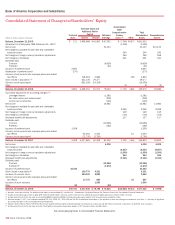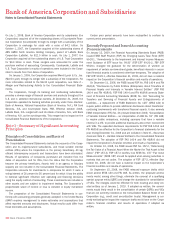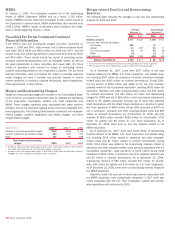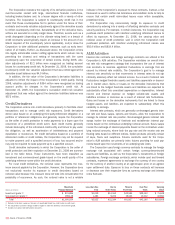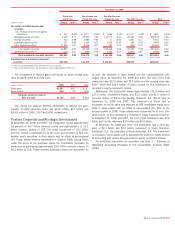Bank of America 2008 Annual Report Download - page 129
Download and view the complete annual report
Please find page 129 of the 2008 Bank of America annual report below. You can navigate through the pages in the report by either clicking on the pages listed below, or by using the keyword search tool below to find specific information within the annual report.remote and beyond the control of the seller. QSPEs are not included in
the Corporation’s Consolidated Financial Statements. When the Corpo-
ration securitizes assets, it may retain a portion of the securities, sub-
ordinated tranches, interest-only strips, subordinated interests in accrued
interest and fees on the securitized receivables, and, in some cases,
overcollateralization and cash reserve accounts, all of which are generally
considered retained interests in the securitized assets. The Corporation
may also retain senior tranches in these securitizations. Gains and
losses upon sale of the assets are based on an allocation of the previous
carrying amount of the assets to the retained interests. Carrying amounts
of assets transferred are allocated in proportion to the relative fair values
of the assets sold and interests retained.
Quoted market prices are primarily used to obtain fair values of senior
retained interests. Generally, quoted market prices for retained residual
interests are not available; therefore, the Corporation estimates fair val-
ues based upon the present value of the associated expected future cash
flows. This may require management to estimate credit losses, prepay-
ment speeds, forward interest yield curves, discount rates and other fac-
tors that impact the value of retained interests. See Note 8 –
Securitizations to the Consolidated Financial Statements for further dis-
cussion.
Interest-only strips retained in connection with credit card securitiza-
tions are classified in other assets and carried at fair value, with changes
in fair value recorded in card income. Other retained interests are
recorded in other assets, AFS debt securities, or trading account assets
and are carried at fair value or amounts that approximate fair value with
changes recorded in income or accumulated OCI. If the fair value of such
retained interests has declined below its carrying amount and there has
been an adverse change in estimated contractual cash flows of the under-
lying assets, then such decline is determined to be other-than-temporary
and the retained interest is written down to fair value with a correspond-
ing adjustment to other income.
Other Special Purpose Financing Entities
Other special purpose financing entities (SPEs) (e.g., Corporation-
sponsored multi-seller conduits, collateralized debt obligations, asset
acquisition conduits) are generally funded with short-term commercial
paper. These financing entities are usually contractually limited to a nar-
row range of activities that facilitate the transfer of or access to various
types of assets or financial instruments and provide the investors in the
transaction protection from creditors of the Corporation in the event of
bankruptcy or receivership of the Corporation. In certain situations, the
Corporation provides liquidity commitments and/or loss protection
agreements.
The Corporation determines whether these entities should be con-
solidated by evaluating the degree to which it maintains control over the
financing entity and will receive the risks and rewards of the assets in the
financing entity. In making this determination, the Corporation considers
whether the entity is a QSPE, which is generally not required to be con-
solidated by the seller or investors in the entity. For non-QSPE structures
or VIEs, the Corporation assesses whether it is the primary beneficiary of
the entity. In accordance with FIN 46R, the entity that will absorb a
majority of expected variability (the sum of the absolute values of the
expected losses and expected residual returns) consolidates the VIE and
is referred to as the primary beneficiary. As certain events occur, the
Corporation reevaluates which parties will absorb variability and whether
the Corporation has become or is no longer the primary benefi-
ciary. Reconsideration events may occur when VIEs acquire additional
assets, issue new variable interests or enter into new or modified con-
tractual arrangements. A reconsideration event may also occur when the
Corporation acquires new or additional interests in a VIE. For additional
information on other SPEs, see Note 9 – Variable Interest Entities to the
Consolidated Financial Statements.
Fair Value
The Corporation measures the fair market values of its financial instru-
ments in accordance with SFAS 157, which requires an entity to maximize
the use of observable inputs and minimize the use of unobservable
inputs to determine the exit price. Also in accordance with SFAS 157, the
Corporation categorizes its financial instruments, based on the priority of
inputs to the valuation technique, into a three-level hierarchy, as dis-
cussed below. Trading account assets and liabilities, derivative assets
and liabilities, AFS debt and marketable equity securities, MSRs, and
certain other assets are carried at fair value in accordance with various
accounting literature, including SFAS No. 115, “Accounting for Certain
Investments in Debt and Equity Securities (SFAS 115), SFAS 133, SFAS
156 and broker dealer or investment company guidance. The Corporation
has also elected to carry certain assets and liabilities at fair value in
accordance with SFAS 159 including certain corporate loans and loan
commitments, LHFS, structured reverse repurchase agreements, and
long-term deposits. SFAS 159 allows an entity the irrevocable option to
elect fair value for the initial and subsequent measurement for certain
financial assets and liabilities on a contract-by-contract basis.
Level 1 Quoted prices in active markets for identical assets or
liabilities. Level 1 assets and liabilities include debt and equity
securities and derivative contracts that are traded in an active
exchange market, as well as certain U.S. Treasury securities
that are highly liquid and are actively traded in over-the-counter
markets.
Level 2 Observable inputs other than Level 1 prices, such as quoted
prices for similar assets or liabilities; quoted prices in markets
that are not active; or other inputs that are observable or can
be corroborated by observable market data for substantially the
full term of the assets or liabilities. Level 2 assets and
liabilities include debt securities with quoted prices that are
traded less frequently than exchange-traded instruments and
derivative contracts whose value is determined using a pricing
model with inputs that are observable in the market or can be
derived principally from or corroborated by observable market
data. This category generally includes U.S. government and
agency mortgage-backed debt securities, corporate debt secu-
rities, derivative contracts, residential mortgage and certain
LHFS.
Level 3 Unobservable inputs that are supported by little or no market
activity and that are significant to the fair value of the assets or
liabilities. Level 3 assets and liabilities include financial
instruments whose value is determined using pricing models,
discounted cash flow methodologies, or similar techniques, as
well as instruments for which the determination of fair value
requires significant management judgment or estimation. This
category generally includes certain private equity investments,
retained residual interests in securitizations, residential MSRs,
asset-backed securities (ABS), highly structured, complex or
long-dated derivative contracts, certain LHFS, IRLCs and certain
collateralized debt obligations (CDOs) where independent pric-
ing information was not able to be obtained for a significant
portion of the underlying assets.
For more information on the fair value of the Corporation’s financial
instruments see Note 19 – Fair Value Disclosures to the Consolidated
Financial Statements.
Bank of America 2008
127



